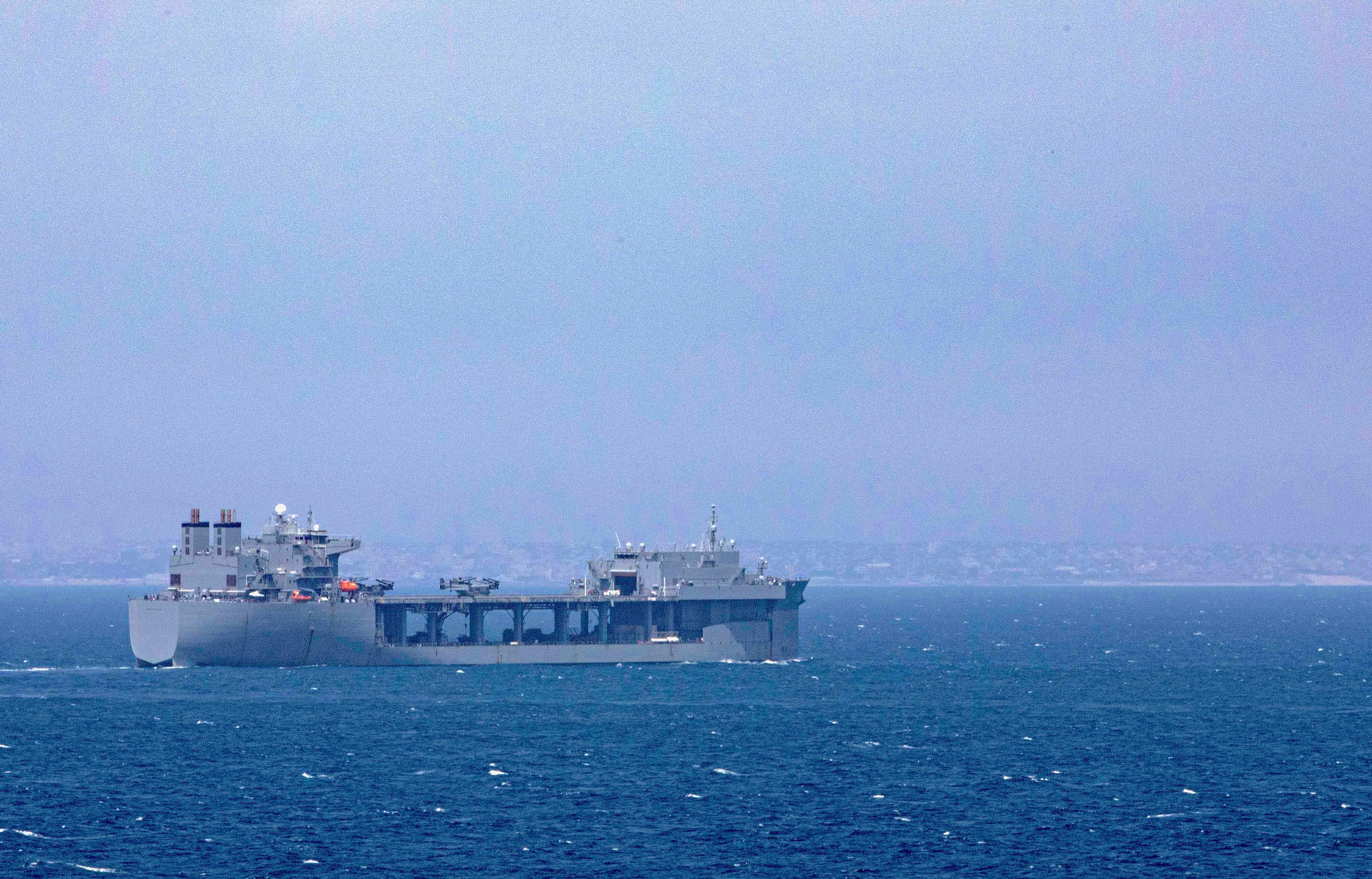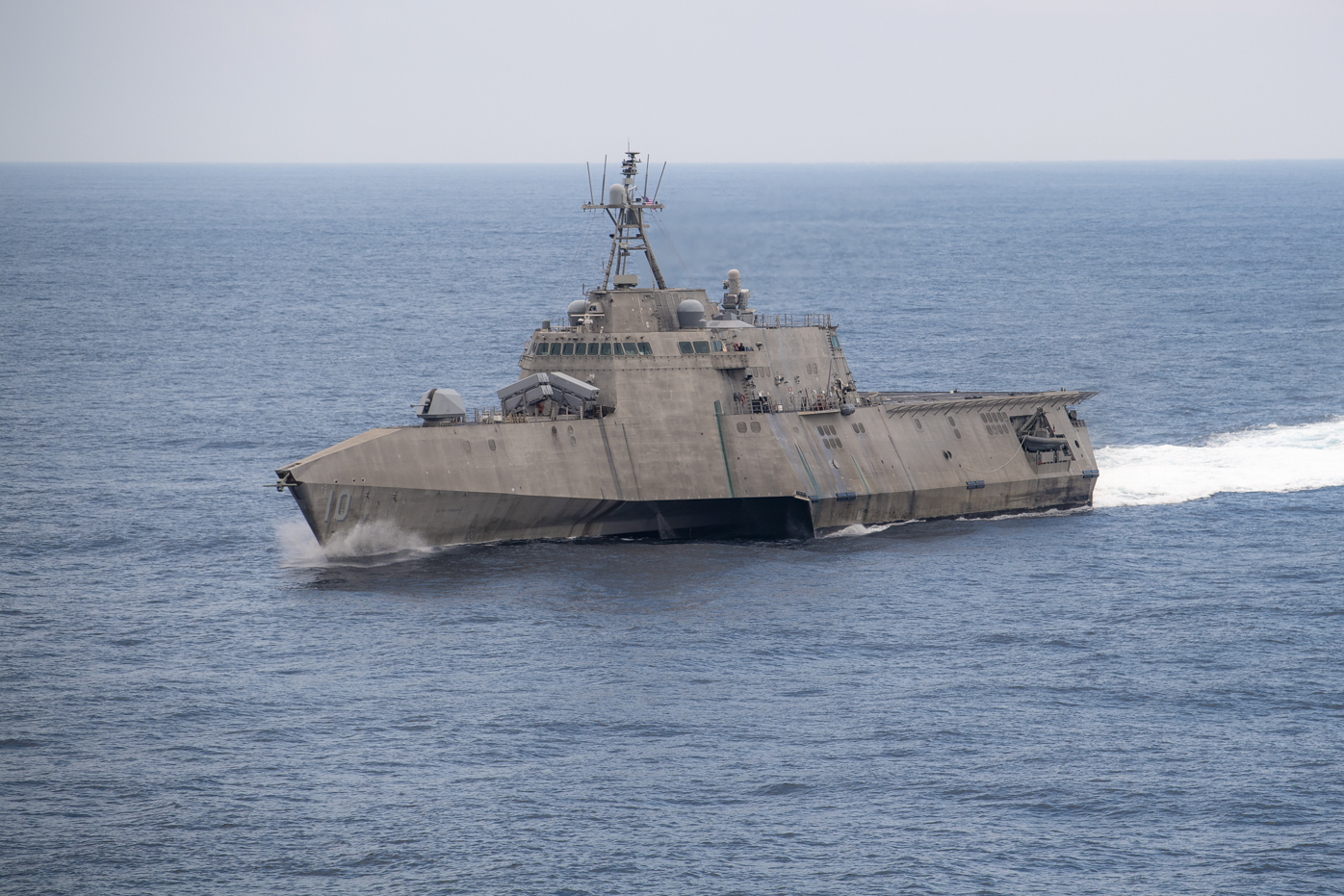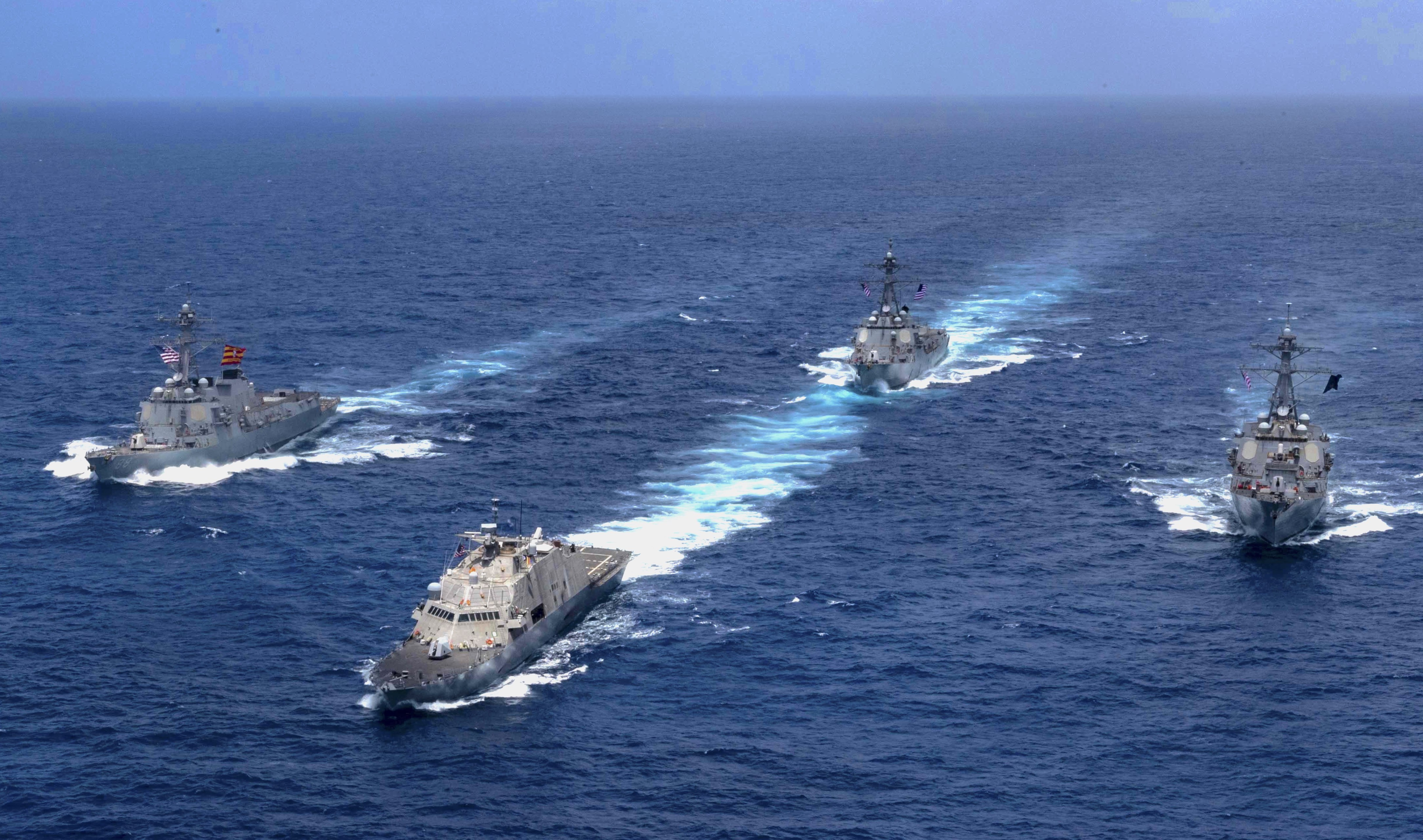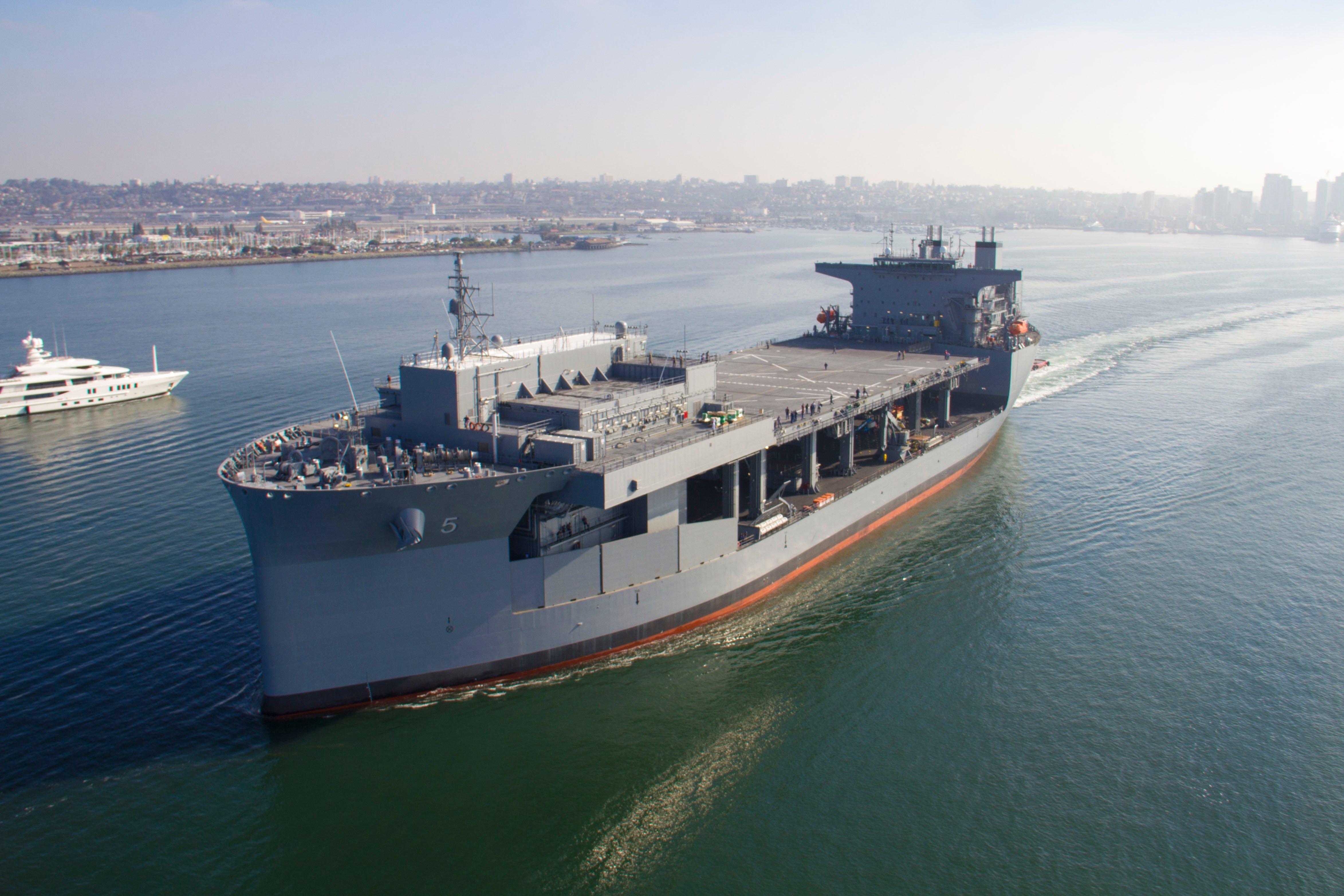
Surface warfare leaders throughout the Navy last week mused about how to employ new classes of ships such as the Littoral Combat Ship and Expeditionary Sea Base, as the fleet transitions to a new type of operations against peer competitors.
While much of the talk around implementing concepts like Distributed Maritime Operations (DMO) and Expeditionary Advance Base Operations (EABO) have centered on brand new ship classes – the Light Amphibious Warship, the Next-Generation Logistics Ship and the Large Unmanned Surface Vessel – there’s a set of ship classes that are still new and finding their place in the fleet that could be quite useful to DMO and EABO, these leaders said last week at the annual Surface Navy Association symposium.
Among these ships is the LCS.
Commander of Naval Surface Forces Vice Adm. Roy Kitchener said last week that the LCS is already being eyed to support Navy-Marine Corps EABO operations, and their utility there would only grow as the ships are made more lethal.
“I talk a lot with [U.S. 7th Fleet Commander Vice Adm. Bill Merz] out here, a big fan of LCS. If you look at the things we want to do in the 7th Fleet warfight, and you look at LOCE (Littoral Operations in a Contested Environment) and EABO and things like that, that’s what he wants to use them for,” Kitchener said.
“And there’s a lot of capability there. Every LCS now is getting NSM, the (naval) strike missile, so that’s a capability that we’re really excited about. … In the fight out here, that’s exactly what we’re looking at, is integrating there in the littoral, bringing that strike capability.”
The new Light Amphibious Warships will be the primary ships conducting EABO, carrying groups of about 75 Marines as they maneuver around island chains and shorelines, stopping to conduct missions ashore and then heading back out to sea to evade targeting by the adversary. Though the Marines will carry some land-based anti-ship missiles with them, integrating LCS into that mission set would provide a sea-based strike capability for the Marines as they move around and conduct their missions.

While 7th Fleet is eyeing the LCSs to perform strike and EABO missions, U.S. Southern Command is eyeing the ships for their strengths in counter-drug missions.
During his keynote address at SNA, SOUTHCOM Commander Adm. Craig Faller said the platform has helped his combatant command perform anti-drug missions. As the Trump administration ramped up its counter-drug operations last year, Navy warship presence within U.S. 4th Fleet increased.
“I think deploying them here on these short patrols into SOUTHCOM [area of responsibility] is a good test to their capability, builds confidence in the crew. It has made a difference in the threat,” Faller said of the LCS. “When they come with unmanned – [MQ-8C] Firescout – and [helicopters] and the large flight deck, there’s a lot of flexibility there. And that flexibility has proven itself. And they’ve had a very good track record of taking down illicit traffickers and deterring illicit trafficking by their very presence.”
In the coming years, the LCSs will only grow more lethal and survivable to take on whatever mission fleet commanders ask of them.
In a separate panel at the SNA symposium, Program Executive Officer for Unmanned and Small Combatants Rear Adm. Casey Moton said that a lethality and survivability package of upgrades would be coming to the LCSs soon.
“We have major upgrades for the ship combat systems planned,” he said, referring to a long-talked-about L&S package to backfit LCSs with some of the upgrades that were added later in the production line.
”The ships right now are getting [the Naval Strike Missile over-the-horizon missile], but starting in FY ‘23 they’ll get a more comprehensive upgrade to improve their lethality and survivability. And design efforts are proceeding in earnest this year” at PEO USC and PEO Integrated Warfare Systems.
Moton added that the package included upgrading the Independence-variant ships to an Aegis-based common combat system, adding the Nulka decoy system and the SEWIP Lite electronic warfare package to all the LCSs in the fleet, along with other upgrades.
“The bottom line is, LCSs with Naval Strike Missiles, along with the rest of our fleet, are all going to be platforms which can’t be ignored by a potential adversary. So the intention is for them all to have that capability,” he said.
Kitchener said in his speech that the LCSs would be “on the front lines” in the Pacific and that the fleet would keep pushing to make them as lethal and as reliable as possible for any future fight.

“I see it as a fairly youthful platform, and I think we’ve learned a lot with these deployments, and we’re figuring out how to make them more lethal, and we think we’ve figured out what missions we want them to do out there, and so I think it’s going to be kind of exciting,” he said.
“We’ve just got to deliver: we’ve got to deliver with a sustained plan of, okay, how many are we going to get out there next year, how many the following year, and we’ve got to meet that requirement. So that’s the challenge.”
In addition to the LCS, combatant commanders are considering how to use the large, flexible ESBs in their theaters. USS Lewis B. Puller (ESB-3) is based in Bahrain to support missions in U.S. 5th Fleet, and last year USS Hershel “Woody” Williams (ESB-4) was sent to operate out of Souda Bay, Greece, in support of U.S. Africa Command.
Faller said he has sought an ESB for his area of responsibility, arguing SOUTHCOM is a good region to test out operational concepts.
“I strongly support one here in this theater. I made that pitch during the combatant command review. Then-[Defense Secretary Mark] Esper agreed with me, asked the services to look at prioritization. We’re still working through that. But there is future plans to have one in this region,” Faller said.
“And I know that our Marine Corps forces … will use that as an expeditionary platform. This is a great theater to test concepts. We’re short distances from [Naval Base] San Diego and [Naval Station] Mayport and big training ranges and capable partners. Peru has an amphibious shipbuilding capability and they welcome that type of training, for one example.”
While SOUTHCOM hopes to get an ESB, 7th Fleet is likely to get the future USS Miguel Keith (ESB-5), the next ship in the class the Navy will commission. U.S. Indo-Pacific Command chief Adm. Phil Davidson said last week he could use the ESB in regional exercises and that the vessel would help the joint force in its current transitional phase.
“Access to the region in competition – day-to-day, phase zero, how it will be employed – and on the road to crisis, and then in conflict, is going to be critically important. And the ESB, with the developing concepts, naval and joint, is going to be a critical component of that,” Davidson said when asked how he could use an ESB operationally.

“In the competition phase, some of the things that we can do to enhance our design and posture in the region would include the use of exercise-related construction, a facilitation and housing of Seabees, [Rapid Engineer Deployable Heavy Operational Repair Squadron Engineers], things like that – that could build command and control nodes, warehouses, runways, seaports, things like that,” he continued.
“That brings exceptional capability. Additionally, bringing to our exercise program here – joint under INDOPACOM authority, certainly the kind of exercises that [U.S. Pacific Fleet] does under the resources provided by the service – there is plenty of opportunity for ESB interaction there too.”
Though, as Faller and Davidson suggested, the ESB platform is ripe for experimentation, one speaker last week foot-stomped the ESB’s original mission: mine warfare.
Maj. Gen. Tracy King, the director of expeditionary warfare on the chief of naval operations’ staff (OPNAV N95), said during the symposium that “the ESB is a blank pallet. … You can do just about whatever you want to. If I’m not mistaken, it’s the second-largest landing space in the fleet, so it’s got a beautiful [flight deck], several landing spots. With some additional modifications she can theoretically take [Joint Strike Fighter] if we wanted to. MV-22s. Right now we’re putting habitability pods on them to double the size of the deployed contingent. She can easily handle that. But when you walk around, it’s got lots of space, has plug-and-play capabilities.”
Though that space could be used for any number of things – hosting special operations forces, acting as a lilypad for Marines conducting EABO, serving as a forward medical facility, or more – King reminded the audience of the ESB’s strength for mine countermeasures missions.
“Talking to the Woody Williams skipper and the other ESB skippers, they are not at all fearful of mines because it’s highly survivable,” he said.
“We’re going to get surprised – even though we want to keep the man out of the minefield, if you’re going to get close to a minefield, it’s probably best to be in an ESB because she can take a hit and keep on ticking.”





